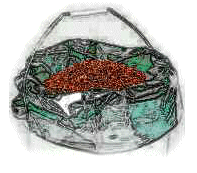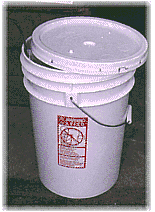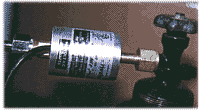


 he
scientific principles which govern proper long-term food
storage are well-known, and yet there is quite a bit of variance
among those in the long-term food storage business as to their
methodologies. We've gotten numerous queries from our
regular customers, as well as prospective purchasers, as to
what techniques we use to preserve our Y2K meal systems. he
scientific principles which govern proper long-term food
storage are well-known, and yet there is quite a bit of variance
among those in the long-term food storage business as to their
methodologies. We've gotten numerous queries from our
regular customers, as well as prospective purchasers, as to
what techniques we use to preserve our Y2K meal systems.
 Initially, knowing
from experience that our meals, with their low A(w), or
free water content, and high pH and solutes, could last for
several years, we used conventional polyprop packaging and
strong corrugated boxing. Initially, knowing
from experience that our meals, with their low A(w), or
free water content, and high pH and solutes, could last for
several years, we used conventional polyprop packaging and
strong corrugated boxing.
 This month, we converted
our packaging systems to our own version of the "super pail,"
and began employing the following techniques. We decided to
make this change as a matter of added long-term storage insurance,
so that the product would, indeed, have a guaranteed 5 year
shelf-life. This month, we converted
our packaging systems to our own version of the "super pail,"
and began employing the following techniques. We decided to
make this change as a matter of added long-term storage insurance,
so that the product would, indeed, have a guaranteed 5 year
shelf-life.
 Thick, High Air Barrier Polyprop
Thick, High Air Barrier Polyprop
and/or Metalized Polyester (Mylar)
 We've had over 12 years experience in working with a wide variety
of laminated packaging materials:
styrene, polypropylene, metalized polyester,
etc. We know their properties because it's our business: virtually
all Lumen Foods' own meat replacement products
are what food technicians call "intermediate
moisture" or "IM mode" foods. That is, they fall between 15% and
50% moisture -- the low end of that scale in our case.
We've had over 12 years experience in working with a wide variety
of laminated packaging materials:
styrene, polypropylene, metalized polyester,
etc. We know their properties because it's our business: virtually
all Lumen Foods' own meat replacement products
are what food technicians call "intermediate
moisture" or "IM mode" foods. That is, they fall between 15% and
50% moisture -- the low end of that scale in our case.
 In working with U.S. World Foods
we developed a dry-blend business that pulled these moisture figures
more in the 4% to 12% range. Most foods that are 4% or under in
moisture content, unless they are high in fats, are fairly easy
to store in a cool, dry place -- provided they are given protection
from outside contamination or infestation. If you rise above that
figure, you usually need protection from moisture and/or
ambient oxygen. In working with U.S. World Foods
we developed a dry-blend business that pulled these moisture figures
more in the 4% to 12% range. Most foods that are 4% or under in
moisture content, unless they are high in fats, are fairly easy
to store in a cool, dry place -- provided they are given protection
from outside contamination or infestation. If you rise above that
figure, you usually need protection from moisture and/or
ambient oxygen.
 Without trying to get too
technical, there are several other factors that enter into the
food storage equation when choosing a packaging "film": Without trying to get too
technical, there are several other factors that enter into the
food storage equation when choosing a packaging "film":

 Available Moisture - As alluded to above, there is the
amount of "free water," which when expressed as a ratio to water
which cannot be used by organisms to reproduce ("bound water"),
is known as the Aw factor. All Lumen Foods' Y2K meal systems
have a naturally low Aw factor, which automatically helps their
shelf-life.
Available Moisture - As alluded to above, there is the
amount of "free water," which when expressed as a ratio to water
which cannot be used by organisms to reproduce ("bound water"),
is known as the Aw factor. All Lumen Foods' Y2K meal systems
have a naturally low Aw factor, which automatically helps their
shelf-life.

 pH Factor - Foods, whether assisted by naturally-occurring
acidic preservatives or because of the addition of food grade
acidulents or both, tend to last longer when their are on the
acidic or low pH side. Numerous studies have shown that preservatives,
that is compounds, natural or man-made, which act as shelf-life
extenders in foods, generally work better in a more acidic
environment. All Lumen Foods', with only minor exceptions,
fall in the 3.2 to 4.8 range. That is, they are mildly
acidic, helping to fend off microorganisms - especially with
the assistance of potassium sorbate in our
own meat replacements.
pH Factor - Foods, whether assisted by naturally-occurring
acidic preservatives or because of the addition of food grade
acidulents or both, tend to last longer when their are on the
acidic or low pH side. Numerous studies have shown that preservatives,
that is compounds, natural or man-made, which act as shelf-life
extenders in foods, generally work better in a more acidic
environment. All Lumen Foods', with only minor exceptions,
fall in the 3.2 to 4.8 range. That is, they are mildly
acidic, helping to fend off microorganisms - especially with
the assistance of potassium sorbate in our
own meat replacements.

 Light Emissions -
Light produces heat and heat ages most foods. For this reason,
metalized polyester is popular in the food storage business because
it is opaque (non-transparent) and helps block out light. Lumen
Foods uses metalized polyester sparingly where the food in
question needs extra protection. Most of the benefits of
this material (often called "Mylar" even though this is just
a Dupont trademark and there are many other films on the market
that are also made of metalized polyester that do essentially the
same thing) are cancelled if the food to be stored is simply kept
in a cool, dry DARK place anyways. Light Emissions -
Light produces heat and heat ages most foods. For this reason,
metalized polyester is popular in the food storage business because
it is opaque (non-transparent) and helps block out light. Lumen
Foods uses metalized polyester sparingly where the food in
question needs extra protection. Most of the benefits of
this material (often called "Mylar" even though this is just
a Dupont trademark and there are many other films on the market
that are also made of metalized polyester that do essentially the
same thing) are cancelled if the food to be stored is simply kept
in a cool, dry DARK place anyways.
 Nitrogen or CO2 Gas Flushing?
Nitrogen or CO2 Gas Flushing?
Plus Oxygen Absorbers.
 Besides moisture, the
next greatest threat to storable foods is O2, or atmospheric
oxygen. Minimizing oxygen is critical because without eliminating
oxygen, insect infestation and microorganisms can wreak havoc.
Also, fats cannot go rancid (oxidize) without oxygen, and virtually
all grains, beans, nuts, and seeds contain fats. Besides moisture, the
next greatest threat to storable foods is O2, or atmospheric
oxygen. Minimizing oxygen is critical because without eliminating
oxygen, insect infestation and microorganisms can wreak havoc.
Also, fats cannot go rancid (oxidize) without oxygen, and virtually
all grains, beans, nuts, and seeds contain fats.

 We use
heated CO2 gas, as well as liquid nitrogen, in our
operation. We have found that each have their strength:
CO2 is heavier than nitrogen and serves better in some applications.
Whereas foods with higher moisture contents should not be packed
with CO2 because of the opportunity for creation of unwanted
carbonic acid. We use
heated CO2 gas, as well as liquid nitrogen, in our
operation. We have found that each have their strength:
CO2 is heavier than nitrogen and serves better in some applications.
Whereas foods with higher moisture contents should not be packed
with CO2 because of the opportunity for creation of unwanted
carbonic acid.
 In addition, for added
security we use oxygen absorbers. These
oxygen-stealing pouches not only grab remaining oxygen in the
pail after it has been sealed, but they help create a slight
suction within the pail itself. If you have not already done so,
you might want to read our section on
oxygen absorbers. In addition, for added
security we use oxygen absorbers. These
oxygen-stealing pouches not only grab remaining oxygen in the
pail after it has been sealed, but they help create a slight
suction within the pail itself. If you have not already done so,
you might want to read our section on
oxygen absorbers.
 The Final Touches
The Final Touches
 It doesn't do any good
to create a low moisture, virtually oxygen-free container if
oxygen has a way of re-entering the container after its sealed.
For this reason, we take special precautions to ensure that
the lid, with its embedded rubber seal, is firmly seated on
the body of the pail. It doesn't do any good
to create a low moisture, virtually oxygen-free container if
oxygen has a way of re-entering the container after its sealed.
For this reason, we take special precautions to ensure that
the lid, with its embedded rubber seal, is firmly seated on
the body of the pail.
 All pails are kept
in an FDA-approved warehousing facility that is regularly
monitored for pests and other sources of infestation. All pails are kept
in an FDA-approved warehousing facility that is regularly
monitored for pests and other sources of infestation.
 Finally, your super
storage pail is shipped on an approved carrier (either UPS
or common carrier) with special "fragile" markings to alert
delivery personnel as to the special care we want for our
customers' product. Finally, your super
storage pail is shipped on an approved carrier (either UPS
or common carrier) with special "fragile" markings to alert
delivery personnel as to the special care we want for our
customers' product.
 Before ordering, we
ask that you thoroughly read through the Y2K portion of
our FAQ pages. However, if you
have further questions about any aspect of our
preservation process, please
email us. Before ordering, we
ask that you thoroughly read through the Y2K portion of
our FAQ pages. However, if you
have further questions about any aspect of our
preservation process, please
email us.
Lumen Foods' Home Page
 Lumen Foods' Y2K Storable Foods
Lumen Foods' Y2K Storable Foods
|


 he
scientific principles which govern proper long-term food
storage are well-known, and yet there is quite a bit of variance
among those in the long-term food storage business as to their
methodologies. We've gotten numerous queries from our
regular customers, as well as prospective purchasers, as to
what techniques we use to preserve our Y2K meal systems.
he
scientific principles which govern proper long-term food
storage are well-known, and yet there is quite a bit of variance
among those in the long-term food storage business as to their
methodologies. We've gotten numerous queries from our
regular customers, as well as prospective purchasers, as to
what techniques we use to preserve our Y2K meal systems.  Thick, High Air Barrier Polyprop
Thick, High Air Barrier Polyprop Nitrogen or CO2 Gas Flushing?
Nitrogen or CO2 Gas Flushing?
 The Final Touches
The Final Touches